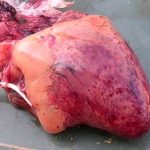Fowlpox is a viral disease that causes skin lesions on the unfeathered parts and diphtheria or proliferative lesions on the upper parts of the digestive and respiratory tracts. Systemic infection is also possible. It is an important disease that has been known for a long time and is still a strong health constraint in hot regions and of increasing importance in Europe.
The disease agent and its pathogenicity
The etiological agent of fowlpox is a poxvirus, of the Poxviridae family . There are different genetic types : fowlpoxvirus, canarypoxvirus, psittacinepoxvirus, also called clades A, B and C. This virus has a rectangular shape and measures approximately 280 by 330 by 200 nm. It is a double-stranded DNA virus surrounded by 2 layers of membranes. The nucleus is biconcave and central.
The virus is very resistant in the external environment, mainly in the skin crusts. It is inactivated by many disinfectants. Caustic soda at 1%¨, heating at 50°c for 30 minutes or 60°c for 8 minutes inactivates the virus.
This virus replicates in the cytoplasm of epithelial cells and causes intra cytoplasmic inclusions. The virus is formed within 72-96 hours after infection. Animals develop immunity of varying effectiveness.
Epidemiological data
Fowlpox affects many species : chicken, turkey, pigeon, pheasant, quail. It is mostly found in hot countries, but its incidence is increasing in France, especially in laying hens.
The disease affects all ages, but is more rarely seen in youngs. Its frequency is higher in autumn. It is more often found in multi-age farming. High containment and density farms are conducive to the persistence of the disease.
The sources of the disease are carrier birds as well as insects. The virus enters the body through skin lesions caused by pecking, mosquitoes or ticks ; it can also infect breeding turkeys through artificial insemination. The oropharyngeal and tracheal mucous membranes appear to be very susceptible to infection, as trauma is not always necessary for infection. Dust, scales and feather debris are contaminants. Once introduced into a farm, fowlpox spreads slowly, but is very difficult to eliminate.
Clinical manifestations of the disease
Incubation lasts 4 to 14 days.
There are 2 forms : cutaneous form and diphtheric form, which can be encountered together or separately. We also sometimes encounter a systemic form, which remains rare in domestic species.
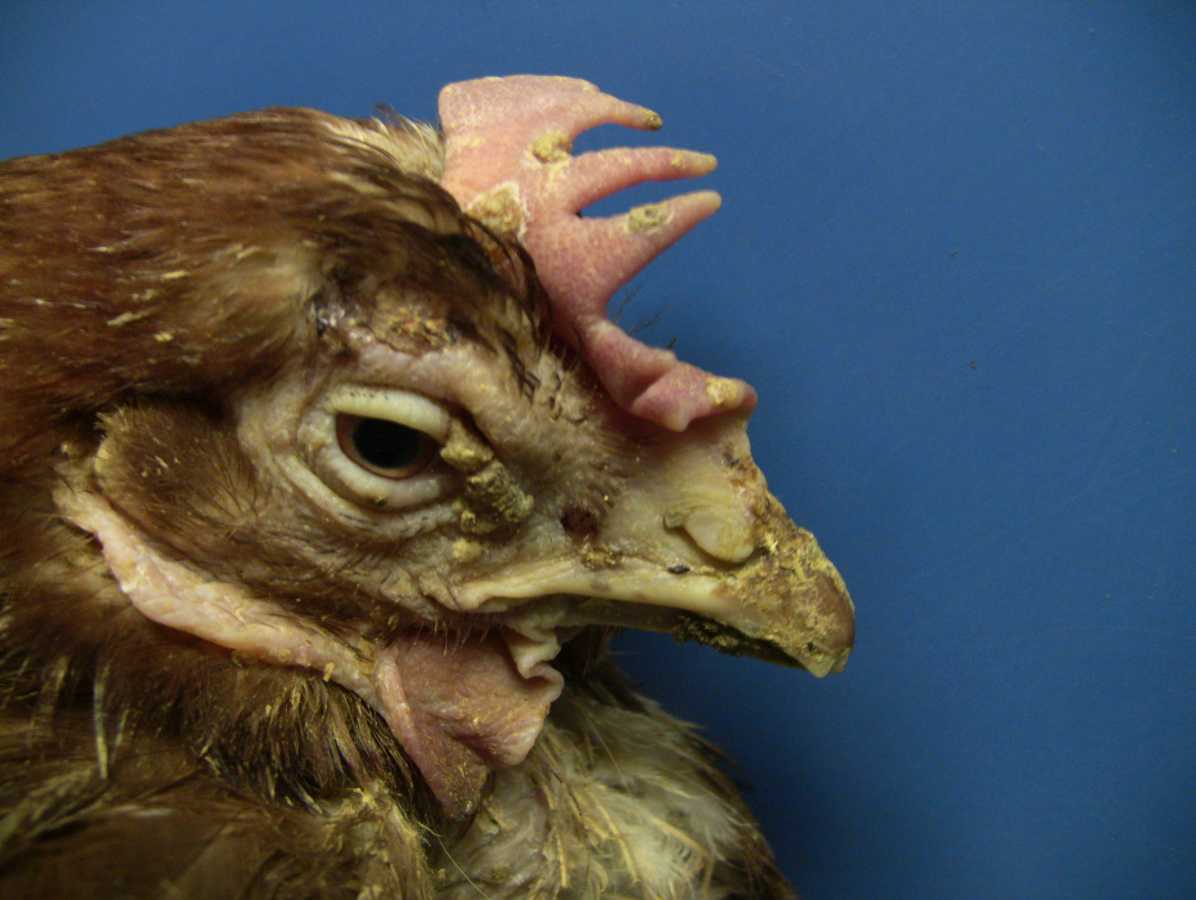
Skin form
Morbidity is high, but mortality is very low.
Fowlpox-like lesions (small whitish crusts) are observed on the unfeathered parts of the head (crest, wattles, around the eyelids, at the corner of the beak and nostrils, cf picture), in the area of the cloaca, and sometimes on the legs of broilers. The lesions develop into papules, then pustules, yellowish vesicles, and finally brown scabs that detach after 3 weeks.
Histology shows proliferation and hyperplasia of epithelial cells of the epidermis and mucous membranes, with eosinophilic intra cytoplasmic inclusions.
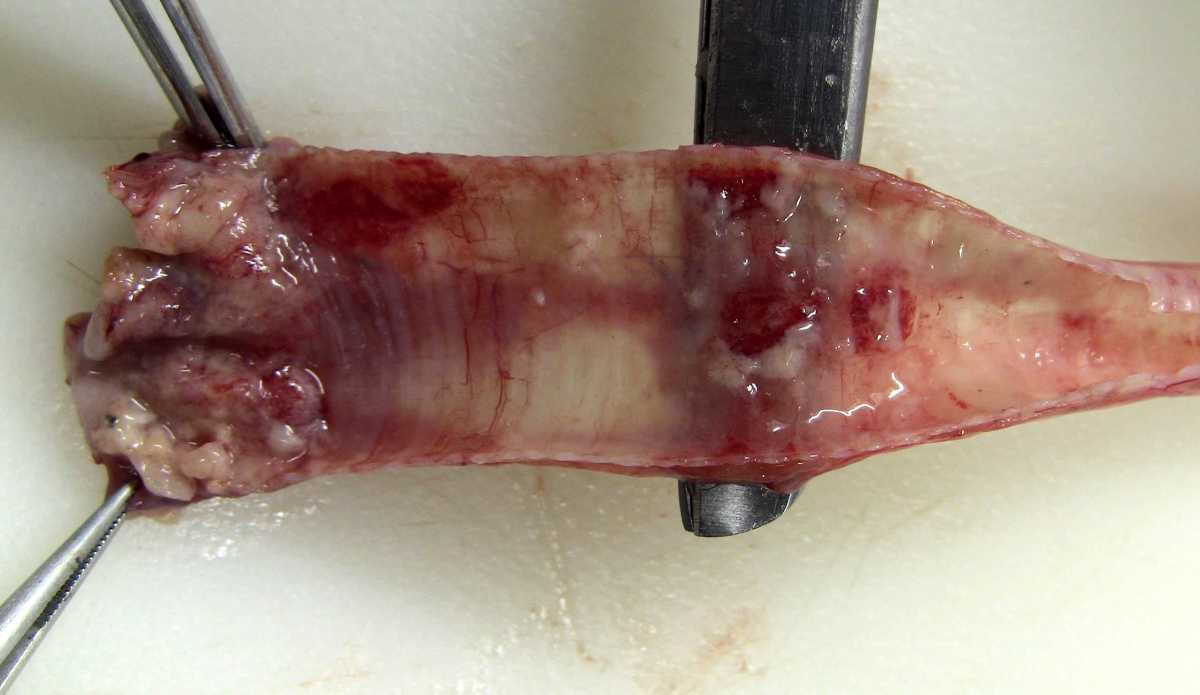
Diphtheria form
Morbidity is higher.
The upper part of the digestive and respiratory systems, and the oral cavity (sinus, nose, oropharynx, esophagus, upper trachea) are affected. Birds have difficulty breathing and asphyxiate, have difficulty swallowing.
Nodules are observed on the mucous membrane with the appearance of whitish, then yellowish diphtheric membranes, of a casedaceous nature, with erosions and haemorrhages under the membranes (cf picture). A drop in production is noted for these animals.
The diagnosis
The clinic and the lesions are often evocative, especially for cutaneous forms. Respiratory forms can be more complex to diagnose.
Laboratory diagnosis
- Histopathology : Histopathological inclusions (“Bollinger bodies”) are characteristic.
- Molecular biology (PCR) : detection of viral DNA on skin lesions or tracheal swabs (respiratory forms)
Differential diagnosis
- Diphtheria form : Infectious laryngotracheitis (ILT), deficiency of biotin or panthotenic acid or vitamin A, intoxications (T2 toxins).
- Pigeon: Trichomoniasis (Trichomonas gallinae).
Disease prevention and control
Sanitary prophylaxis
Improve hygiene, insect control of inects that are mechanical vectors of the virus. Avoid multi-age farming.
Vaccination
Active immunity is of a mixed, cellular and humoral nature. Live attenuated virus vaccines prepared from chicken poxvirus are available. The administration is done by the “wing-web” or transfixion method : a needle dipped in the vaccine is passed through the wing membrane. Oral vaccination is also possible but less effective (50% versus 80-100%).
Layers and breeders are vaccinated between 9 and 14 weeks. Turkeys receive 2 vaccinations : around the 12-14th week and around the 22-24th week. A verification of the vaccination success is to be done 7 to 10 days after vaccination. A swelling of the skin at the injection site and/or a crust is then visible.


